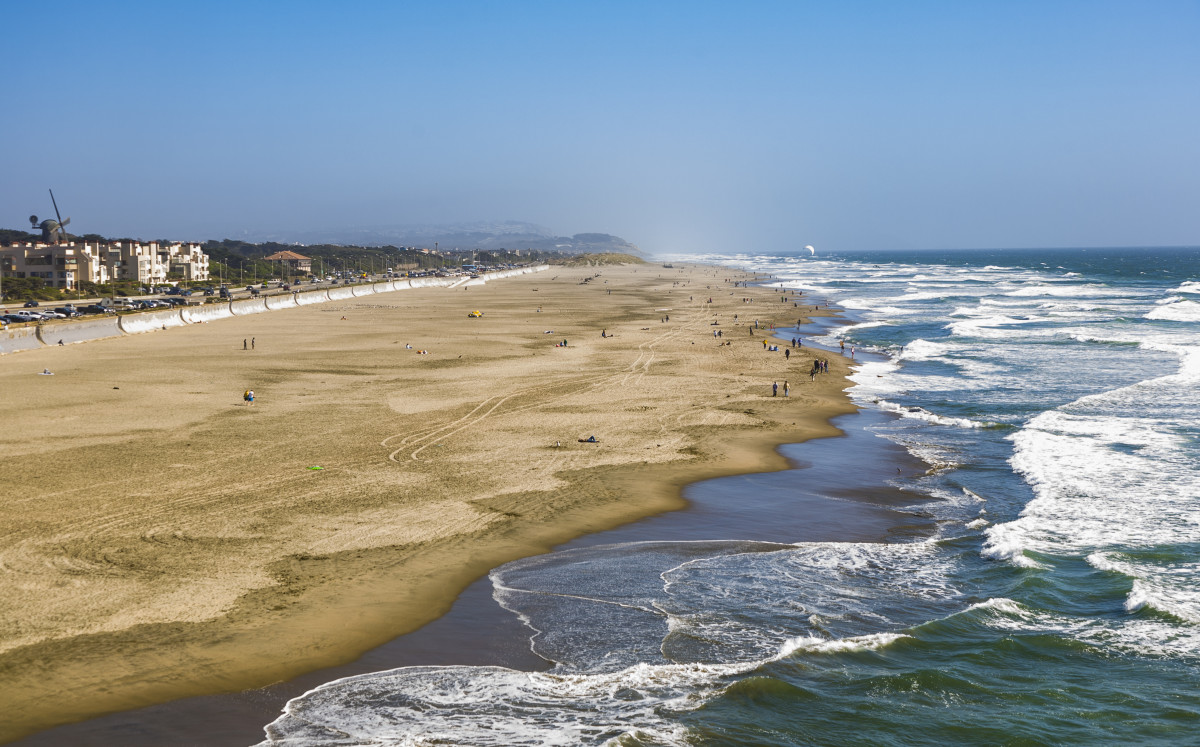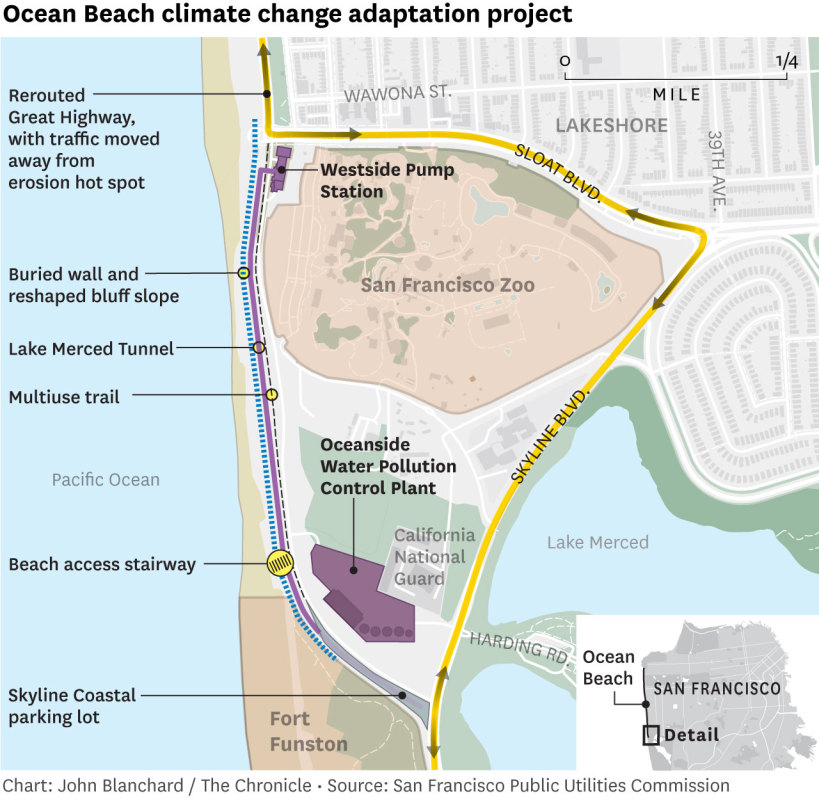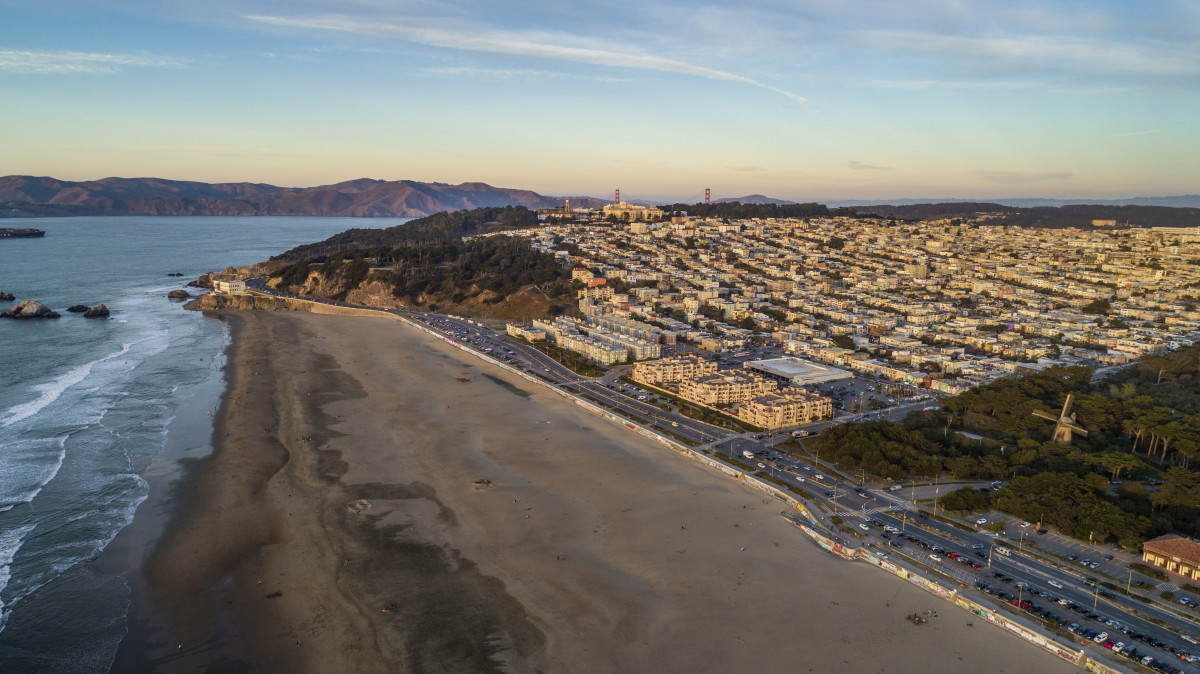
Photo: Getty Images
Update: The California Coastal Commission has postponed its hearing on the Ocean Beach Armoring Project from its June 13 meeting agenda. The San Francisco Public Utilities Commission will review the plans and come before the state in several months. Visit the websites of the Coastal Commission, SFPUC and Surfrider Foundation for updates.
In a way, the south end of Ocean Beach is symbolic of San Francisco. Beautiful, in its own way, but with plenty of grit and grime. Beginning at Sloat Boulevard, the area marks the southern gateway into the city’s western shore and one of California’s most wave-rich and challenging surf spots.
But it’s also in trouble. For many years the area has been challenged by climate-induced erosion of the coastal bluffs, which threatens public access and sewer infrastructure. Now, as a long-term plan to deal with the sea’s ceaseless march, the city has proposed a plan to build a seawall along part of the beach.
On June 13th, the San Francisco Public Utilities Commission will ask the California Coastal Commission to sign off on a massive $250 million armoring project to deal with erosion on the southern end of the Great Highway and Ocean Beach. The full proposal is detailed in this 108-page staff report. But here’s the gist: The SFPUC seeks to build a 3,200-foot seawall along the beach to protect the Lake Merced Tunnel, a 14-foot wide sewer and wastewater pipeline that runs underneath the Great Highway and serves the Oceanside Treatment Plant and related pumping station on Ocean Beach. The idea is that the armoring will protect the infrastructure from sea level rise and extreme storms. The wall will be buried in sand and vegetation planted on the slopes.

Additionally, the city plans to remove the Great Highway Extension because it’s concerned the road is too close to the project area and eroding cliffs. Traffic will be rerouted around the San Francisco Zoo, and 60 parking spaces will be added near the beach. Part of the old roadway extension will have a concrete trail for coastal viewing, biking, and walking. If left unchecked, this segment of the beach is projected to erode by more than 100 feet by 2100, according to the USGS.
As you can imagine, coastal armoring is a controversial strategy in California. It’s generally understood that it can potentially accelerate erosion on adjacent beaches by changing the pattern of sand movement. For years, San Francisco has applied a patchwork of approaches to deal with shifting sands, including sand berms, sandbags and rock revetments. While the wall will be built south of where most surfers usually paddle out at Ocean Beach, any mention of seawalls near waves sparks worry that the sandbars could be forever altered.
Related: Watch Now: A Deep Dive Into the Thriving San Francisco Surf Scene
For more than a decade, The Surfrider Foundation has advocated for some form of climate adaptation project to deal with the erosion issues around Sloat Boulevard. In regards to this recent plan, Surfrider has expressed concern that the sprawling concrete wall on the beach, even with sand, will reduce the amount of sand around Sloat Boulevard. The nonprofit also questioned the long-term viability of the project on its website, stating that the wall and concrete pedestrian path will be very difficult to remove as sea levels continue to rise, and the wall itself will be an additional source of erosion when it is exposed.
“Anytime we armor our shoreline, whether by sea walls, rock revetment, groins, or other means, it disrupts the littoral cells that naturally function in those sites,” said Zach Plopper, Surfrider’s Senior Environmental Director. “These cells transport sand, north to south or south to north, depending on where we are and what season we are in. Armoring doesn’t stop erosion; in fact it may exacerbate sand loss in front of and adjacent to the wall or revetment. It’s a temporary fix to meet our short-term needs in an ever-changing environment.”

Photo: Jason Doiy/Getty Images
This week, Surfrider staff and members plan to ask the Coastal Commission to require major changes before the final plan is approved, changes they believe will make for a more resilient beach and mean relocating wastewater infrastructure. Specifically, Surfrider is asking for:
- An adjusted design of the seawall, stairways and multi-use path so that they are more easily relocated in the future (by making the bike path out of dirt instead of concrete and by using a slat-based design for the seawall).
- A more robust sand management plan to ensure any seawall remains buried in the short term and is not a significant source of erosion.
- A long-term sea level rise adaptation plan with strong triggers, monitoring and planning commitments towards the relocation of the Lake Merced Tunnel before 2100.
The city has estimated that at the current rate of sea level rise and erosion, the wall’s lifespan will be about 80 years, but with continued sand nourishment it could last around 80 years. Even with the wall in place, the city will still have to import sand from the north end of OB to the south side. According to the Coastal Commission, the city estimated that if the wall is exposed, “the proposed project would increase the annualized erosion rate over a ten-year period by up to 0.3 feet per year” where exposure occurs. This is San Francisco’s first major climate change adaptation project. While it’s impossible to say exactly how this could change Ocean Beach, let’s hope they get it right.
“We must remember that beaches are dynamic ecosystems that move and morph over time,” Plopper said. “Static structures on our beaches simply don’t last and come with a lot of unintended consequences such as sand loss and impeded coastal access. There is the opportunity in San Francisco to ensure a natural beach and its benefits for the long term and another seawall for the California coast is not the answer.”
***
Don’t miss another headline from SURFER! Subscribe to our newsletter, follow us on Instagram, and stay connected with the latest happenings in the world of surfing. We’re always on the lookout for amusing, interesting and engaging surf-related videos to feature on our channels.
Whether you’re a professional surfer or just an amateur, we want to see your best footage and help you share it with the world. Submit your video for a chance to be featured on SURFER and our social channels. Be sure to subscribe to our YouTube channel to watch high-quality surf videos.

